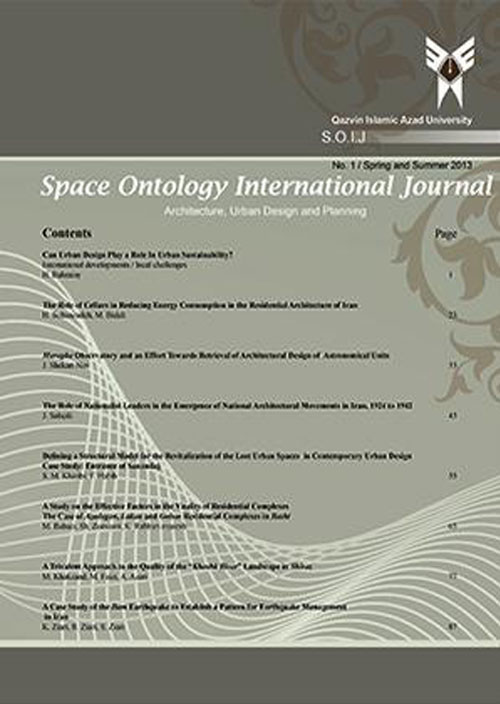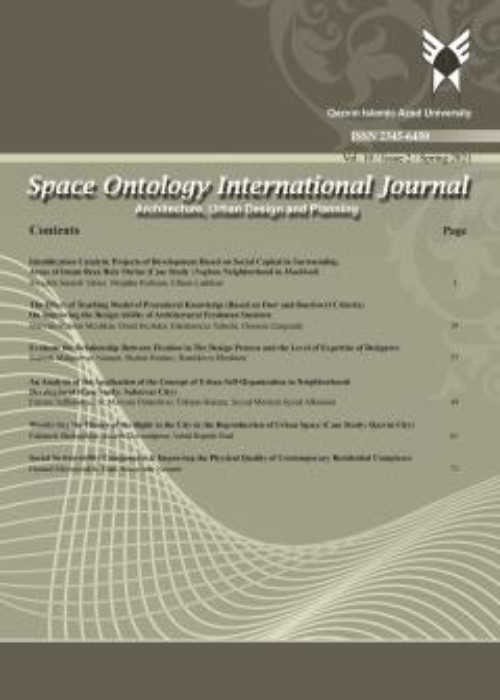فهرست مطالب

Space Ontology International Journal
Volume:10 Issue: 1, Winter 2021
- تاریخ انتشار: 1400/04/16
- تعداد عناوین: 6
-
-
Pages 1-15Outstanding consequences of transport land-use integration under the label of transit-oriented development (TOD) approach in pioneer countries have spurred several newcomers to apply such a policy. Of which, Iran with a centralized planning system has recently provided a TOD national guideline with the purpose of curbing traffic-caused challenges. This study attempts to describe the process applied for the guideline preparation and discover operational challenges and future prospects for TOD successful implementation offering a local edition in Iran. The research has a qualitative approach, based on the case study. Critical analysis of Iranian existing situation together with review of five-year process which ends up with final approval of the guideline, are basic tools applied to investigate the situation. The results demonstrated that although the guideline as a turning point pinpointed the policy of the integration in Iranian policymaking efforts, there are still several barriers to realize TOD policies in Iran including inconsistent urban policies, profit making from TOD potentials, no practical experience, lacking public support and weak local authorities. This study also offers some lessons for such countries with a similar system of urban planning and/or policy challenges, which are planning transport and land use integration.Keywords: Transit-Oriented Development, Policymaking, Urban Planning, Middle East, Iran
-
Pages 17-26
By a vast review of the right to the city literature, this paper tries to understand how the right to the city is perceived by citizens of Tehran. To address this question, 15 Khordaad Pedestrian Street is chosen as our case study. This street is located in the center of Tehran and is a historic, multivalued, and multifunctional street in Tehran, attracting thousands of citizens every day which makes this space, a festival of different gender, and social, economic, and religious groups of people and consequently increases inclusiveness of our findings. The main data presented in this paper are derived from semi-structured interviews with 32 participants according to the data saturation level collected as part of a community-based research project. The qualitative data were generated in 2018, seven years after the implementation of the pedestrian project in 15 Khordaad Street in Tehran. Four general questions were asked in all interviews however we were open to any new idea by applicants. Our findings show that democracy, diversity, and equity are the main pillars of the cries and demands of citizens in our case. Moreover, a paradigm shift from urban management to good governance along with employing a more democratic and collaborative urban design approach coupled with a shift from passive dwellers to active citizens are required to increase right to the city in future similar projects.
Keywords: The right to the city, pedestrian, 15 Khordaad Street, City of Tehran, Impact assessment -
Pages 27-45
There is a growing demand for the construction of high-rise buildings in modern metropolises which calls for accurate and all-encompassing studies to ensure the safety of the residents. The present study examined the role of smoke shafts in the performance of emergency evacuation in high-rise buildings. The aim of the study was to find the optimal location of smoke shafts as well as other refuge areas and components of emergency evacuation in the core structure of high-rise buildings. This study sought to answer the question whether there is a link between the location and number of smoke shafts and the number of people evacuated. The movement of the occupants was simulated using Steering and SFPE simulators. The Fire Dynamic Simulator (FDS) was used for fire and smoke dispersion. The number and location of smoke shafts were considered as the independent variable and the evacuation time as the dependent variable. The findings indicated that including two smoke shafts in connection with the refuge area in the core of high-rise building can accelerate evacuation by up to 40% in case of fire.
Keywords: Smoke Shafts, High-rise Residential Building, Emergency Exit, Fire Dynamics Simulator (FDS) -
Pages 49-60As an urban life support system and as a new method in planning,green infrastructure design can be more effective in the function of natural systems of cities through integration in sustainable regeneration processes as well as integrated and coordinated management of organizations involved. Multiple management systems and disharmony of state organizations and institutions in charge of urban regeneration in green infrastructure is one of the main issues in urban management. In this regard, using green infrastructure indicators in regeneration programs, in this research, conducted in Lahijan in 2019,the organizational relationships of staff members, including state institutions of the city were examined. Also,using descriptive-analytical method and library information, as well as 400 questionnaires distributed among local residents and 50 interviews with city managers as the staff members, after analysis and implication of the data through Pearson correlation,SPSS and social network analysis in UCINET environment, the connection between urban green infrastructure indicators and sustainable regeneration was determined, and the interactions of institutions involved in regeneration were studied.According to the results of the questionnaires, a significance level of under 0.01 was found for green infrastructure and sustainable regeneration components; therefore,as a certain level, the relationship between the indicators of green infrastructure and sustainable regeneration was measured 0.95. In terms of environmental indicators,due to higher correlation coefficients and mean, the impact was higher than the other two indicators.State institutions have a high ability to preserve the urban green heritage by increasing the inter-institutional interactions and awareness.Therefore,in order to realize this approach,it is necessary to raise the awareness of each institution and collaboration among actors to increase the executive power of the staff committee members.Accordingly,the executive power of institutions is based on inter-institutional relations and collaboration and increasing the managers' knowledge about sustainable indicators of regeneration in the rehabilitation of urban green infrastructure of Lahijan.Keywords: sustainable urban regeneration, urban green infrastructure, Sustainable Development, inter-organizational interaction
-
Pages 59-73The unprecedented increase in urban population and the emergence of new issues in the lives of citizens have led to new concepts, such as “right to the city” in the urban planning literature. The answer to many failures of plans and programs in various fields, including environmental justice, can be found in the light of this concept. This paper has focused on the issue of environmental justice through a comprehensive view of the social and economic dimensions of the lives of different groups of city dwellers, and “the right to the city” has been identified as the most appropriate context for this purpose. This descriptive-analytical paper has used documentary studies and a review of the theoretical literature associated with the right to the city and environmental justice to extract the conceptual model indicating the explanation of components and their relationships, using the content analysis model. Finally, the proposed model showed that the establishment of environmental justice in cities requires the realization of the components of the right to the city.Keywords: The right to the city, analytical framework, environmental justice, Content Analysis
-
Pages 75-89Identifying the factors affecting the emergency evacuation process of the occupants at critical times in the burning building and how to exit them to a safe place from fire hazards can play a critical role in the rescue management. An important prerequisite for emergency evacuation of a burning architectural building is the assumption that safety measures designed for the building's architecture against a potential fire are capable of providing appropriate behavioral conditions for effective emergency evacuation at the time of the fire by building occupants. The emergency evacuation process will play an important role in the sustainable design of a building against fire. A review of the scientific literature on the factors affecting emergency evacuation performance in a burning architecture showed that the occupants' behavior was influenced by the architectural environment around them and the burning framework of its own cinemorph building creates its own, which can be quite different to the cinemorph designed by the architect of a different building but also opposed. Studies in the research background show that in order to achieve the evacuation model, there is a pressing need to collect data from the three components of structural characters, fire characters and human characters. This article aims to rank the factors affecting emergency evacuation in the burning building by investigating the impact of each of these characters and identifying the subsets criterion of these characters by extracting data from the questionnaires based on Lisrel's structural equation method and software analysis, and the impact of each criterion. Finally, a conceptual model of the factors influencing successful emergency evacuation in a burning architecture frameworks proposed.Keywords: Fire, burning architecture framework, architecture, way founding


